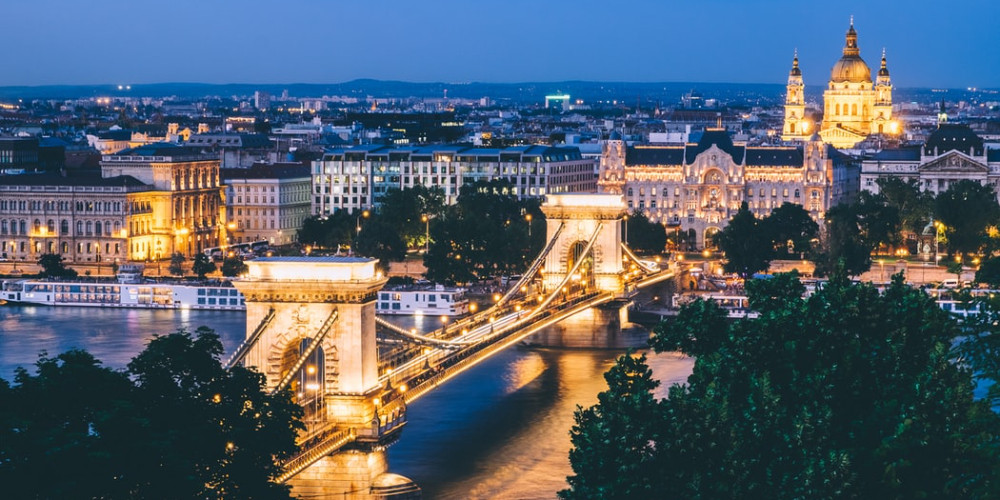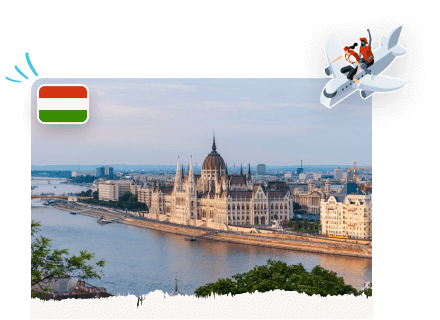
Many people mistakenly think that there is nothing else to see in Hungary except Budapest. Hungary is a small country but undervalued by tourists. Besides the capital of Hungary, it has many other interesting locations: ancient castles and cities, thermal resorts, natural attractions. And the transport accessibility of the country, which can be reached by train, bus, car or plane, makes Hungary one of the most promising destinations for recreation and tourism in central Europe. This article collected 10 basic facts about Hungary that can help you get more information and plan your trip to this country. You will find out where is Hungary located, whether you need a visa here, what currency is in Hungary, and what you can see here.
1. The best time to visit Hungary

If you look at the map of where is Hungary located, it immediately catches your eye that this state is located in the very centre of Europe. Due to its location, the country is covered almost from all sides by different mountains – the Carpathians, Tatras, Alps, which is why the climate here is mild, and the winter is short and snowless. The temperature of the coldest month of the year, January, is kept around zero. Snow falls quite rarely. The best time to visit Hungary is the end of spring and the beginning of autumn. There will be no extreme heat during these months, which is good for excursions and trips around the country. And the thermal baths of Hungary are open all year round so that you can go here at any time of the year.
2. Schengen visa

Hungary has been a member of the European Union since 2004. It is a stable and highly developed country, which is part of the Schengen area, so you need to get a visa to visit Hungary. * Hungary visa for Russians. A regular Schengen visa is required to visit the country. For tourist purposes, Hungarians give it quite willingly. The visa can be either single-entry or multiple-entry. You can get it through the embassy or travel agency. The set of requirements is standard: a valid passport, a certificate of income from work (or a bank statement about the availability of money in the account), medical insurance. * Hungary visa for Ukrainians. Tourists who come to the country with a biometric passport do not need a visa. However, the owners of an ordinary old-style passport must obtain a Schengen visa on general terms.
3. Hungarian language

Hungarian is one of the most difficult modern languages to understand and learn in the world. It belongs to the Finno-Ugric group of languages and is as difficult to learn as Chinese or Mongolian. The closest to it are the Khanty and Mansi peoples' dialects living in Siberia, who are engaged in reindeer husbandry. Before you travel, you should be prepared for the fact that in Hungary you will not understand much. In hotels and tourist places, some of the staff speaks German, but English is rarer. We advise you to learn a dozen of the most commonly used Hungarian words before visiting Hungary to have at least some opportunity to communicate with the locals. Otherwise, upload an app on your phone that translates the written text into Hungarian on the fly.
4. Hungarian currency

Even though Hungary is a member of the EU and the Schengen area, it has retained its historical currency-the forint. In stores, the forint is usually indicated on the price tags as "Ft", in exchange offices-the abbreviation "HUF". It is best to go to Hungary with euros, which are then changed to the local Hungarian currency upon arrival. In stores and restaurants, euros are rarely accepted anywhere, and if they can be paid somewhere, the rate will be unprofitable. It is better to exchange money in exchange offices or banks. The exchange rate at the hotel, airport, and popular tourist locations will be unprofitable. Bank cards are popular in Hungary, but they are not accepted everywhere, so it is better always to carry a small amount in forints.
5. What is the capital of Hungary?

If you are interested in what to see in Hungary then answer is the same - Budapest. The historical and architectural sights of Hungary are mostly concentrated in the capital of Hungary. One of the most beautiful cities in Europe, Budapest, is located on both the Danube River banks, which divides the city into two large parts – Buddha and Pest. Until 1873, these areas were separate cities. In Pest, you should definitely see the Hungarian Parliament building – the hallmark of the city. Built-in the neo-Gothic style in 1885, the parliament is the largest building in Hungary, it consists of 691 rooms and many stairs and passages. The Hungarian Parliament building looks especially beautiful at night from the Danube Embankment, thanks to professional illumination. In the Buddha area, you should pay attention to the famous Buda Fortress, which is a whole area of the city, located on the top of Fortress Mountain. You can climb to the fortress on foot or on the old funicular "Siklo". Tourists are attracted by the royal palace located here. In the past, it was the former residence of the Hungarian kings, and now it is the location of the Historical Museum of Budapest and the Hungarian National Gallery. In the vicinity of the palace are other popular attractions in Hungary-the Fisherman's Bastion and the Church of Matthias. Transport lovers in Budapest can also see one of the oldest subways in Europe, the subway in the city began to work in 1896.
6. A landlocked resort country

Although Hungary has no access to the sea, it is considered the largest international resort because it is home to more than 500 hot thermal springs. Locals joke that if you stick a stick in the ground in Hungary, then a hot water spring will surely clog up from under it. Any traveller is obliged to go at least once to the Hungarian healing baths, some of which resemble real palaces. The most famous bathhouse in the country is Lake Heviz, the largest thermal lake in Europe. It is located in the crater of an extinct volcano. The depth of the lake is more than 40 meters, and the water temperature never drops below 26 degrees Celsius. The Miskolc-Tapolc thermal baths, located in real caves, are also popular with tourists. Here you can see underground halls and lakes with warm water, connected by passages and galleries. The ancient Romans were the first to discover this cave, but it was converted into a bathhouse only at the end of the 18th century. There are also about 100 thermal baths in Budapest, the capital of Hungary. The most famous of them are the baths of Szechenyi and Gellert, which resemble real palaces, but in the Danube River, it is better not to swim – the water in it is quite dirty.
7. The sights of Hungary are not only in the capital

Hungary is a country with a long history. Founded in 896, it is rightfully one of the oldest states in Europe. The turbulent history of Hungary has left its mark on its very diverse attractions. The country is rich in palaces, fortresses, castles, ancient churches, medieval cities, and evenly scattered throughout its territory. What to see in Hungary? * Visegrad Fortress, the former residence of the Hungarian kings. Built-in the Gothic style in the tenth century, the fortress includes a whole complex of ancient buildings – the citadel, the upper and lower castle, the royal palace. * Eger Castle and its historical military museum. This castle is famous for the fact that it could not take the 40-thousandth army of the Ottoman Empire during the invasion of Europe in 1552, despite the fact that only 2 thousand people defended the fortress. * Esterhazy Palace in the city of Ferted in the west of the country. It is the largest palace in Hungary, for the richness and luxury of its interiors, it is often called the "Hungarian Versailles". * The ancient city of Sopron with more than a thousand years of history. Its labyrinths of narrow streets are decorated with numerous towers and spires of churches, buildings in the Gothic style. * The Gedelle Palace-estate in the town of the same name in central Hungary, a masterpiece of Hungarian Baroque architecture. * Pannonhalma Abbey, the oldest monastery in the country, founded at the end of the tenth century. It belongs to the Benedictine Order. * Dioszdier Fortress in Miskolc, built in the 13th century. Various festivals and shows are often held in the courtyard of the building.
8. Hungarian cuisine
 Hungarian cuisine
Hungarian cuisineis rich in meat dishes, made mainly from pork. Hungarians eat fat even more than in Russia or Ukraine. On average, the locals consume half a kilo of fat per week. The most famous Hungarian dish is goulash, although this is not a stew dish in Hungary, but a soup. Interestingly, salami sausage was also invented by the Hungarians, although now the most famous types of salami are produced in Italy. Many dishes in Hungary are prepared with pork fat and seasoned with paprika, onion or hot pepper. In general, Hungarian cuisine is not exactly healthy. When visiting restaurants in Hungary, be sure to try the Debrecen sausages, goulash, meat dishes perkelt or paprikash, cake "Dobosh".
9. The Hungarian Sea, which is not on the map
 Lake Balaton
Lake Balatonis the largest water body in central Europe, which is why it is called the "Hungarian Sea". This lake is 80 km away. it is elongated in length, but it is not deep, which is why the water warms up well in summer, especially in shallow water. The water in the lake is a little muddy but has a beautiful turquoise hue. There are many thermal springs, wellness centers, and hotels in the Balaton area. The sandy beaches and the gently sloping southern shore of the lake are ideal for families with children. But the northern coast is more popular with sailing enthusiasts. The largest resort on the lake is Siofok. Here you can sunbathe on the beach, swim, soak up the thermal springs, go on a yacht or boat, go kiting or windsurfing.
10. The oldest vineyards in Europe

Hungary is home to the first officially documented vineyards in the world. They are located in the Tokai region, known for their Tokai wines. Wine began to be made here in the 5th century, and in 1737 the region received the title of the oldest vineyard in the world. It is now included in the UNESCO World Heritage List. Tokajvineyards are located at an altitude of 100 to 400 meters in small mountains with a special microclimate. Almost every resident has their wine cellar. The most famous local wine is called Assu (Tokaji Aszu). It is made with the help of the noble mold Botrytis cinerea, which makes its taste quite unusual. It is a sweet dessert white wine, which was once especially appreciated by the French king Louis XIV. We hope that the facts about Hungary given in our article will help you plan your trip to this amazing country correctly.


